 |
| Valerian in our garden. |
Biodynamic Prep 507: Challenges of Valerian
Until I was well into my Jungian analysis and had personally experienced the paradox of dark light, I could not have understood the mystery of valerian. We planted the seeds in our garden, not knowing the looks of the plant. When the seeds vigorously sprouted and flowered, I was seduced by the beauty of the copious, fragrantly sweet blossoms. It is said that people either love or hate the fragrance, but I took to it. Because valerian is one of the six Biodynamic compost preparations, plants Rudolf Steiner deemed important to help plants draw what they needed from the cosmos and the earth, I wanted to have its presence on our ranch (it is not native in United States, being brought here by early European settlers). We soon found that although delicate and lace-like, valerian is an extremely extraverted plant— even an invasive—wanting to cozy up to the tomatoes and peppers, move in with the squash. Valerian requires perennial efforts to make sure it does not occupy the whole garden!
But although looking like such light weight, valerian preforms important tasks. As a compost preparation, she (for valerian looks like a she!) regulates the phosphorus processes, “making it possible for the spiritual archetypes to work on the mass of materia” (Lievegoed, The Working of the Planets and the Life Processes in Man and the Earth, p. 31). When we anticipate a frost after the grapes have budded out, we spray valerian to bring in the warmth principle and avoid frost damage. It is said valerian draws earthworms into a garden.
The name phosphorous means “conveyer of light”. Plants need phosphorus in order to grow, as our brains need phosphorus for intelligence. Jungian analyst Edward C. Whitmont likens the homeopathic remedy Phosphor to Lucifer, “the angel who rebelled against the Godhead and conveyed the light of reasoning to men, so that they shall be as gods, knowing good and evil [Genesis 3:5]) (Whitmont, Psyche and Substance: Essays on Homeopathy in the Light of Jungian Psychology, p. 106.). Drawing from Jung’s work on alchemy, Whitmont states, “The symbolic significance of light, as a transcendental force-principle represents the ‘inner spiritual man’, and the qualities of consciousness, wisdom, and intellect (p. 106).” As inner spiritual light, phosphor relates to the alchemical dark light, the sol niger, or Saturn, for which, in fact, valerian has particular affinity (Storl and Steiner).
Saturn represents a psychic process in which we endure painful experiences and feelings, resulting, Goddess willing! in inner spiritual and psychological growth (Liz Green, Saturn). It is that moment in suffering when everything feels alive, the pain, a dark teacher. In alchemy, the base material of transformation, the alchemist himself, was called Saturn. Saturn rules Capricorn, represented by a mountain goat. In meeting the challenges of Saturn, we can scale the mountain of spiritual development with the sure-footedness of a goat.
It is this transformative function that we invite to the compost pile through the valerian tincture, and the warming, brooding it provides. The compost pile is an alchemical alembic, like the analytic container in analysis, in which base material can be transformed.
What histories and mysteries these flowers bring! As above, so below! Valerian, fathomed, draws us into the inner spaces of the psyche through outer spaces of earth. And in our garden, like the goat, it preforms its task with beauty and joy!
 View Our Lavender Products
View Our Lavender Products
